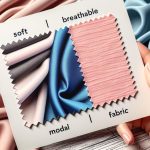If you’re looking for a fabric similar to cotton, you’re in luck! There are several options out there that can give you the same comfortable feel. Linen, rayon, modal, bamboo, and hemp are all great alternatives that offer similar qualities to cotton.
Whether you’re looking for a breathable fabric or one that is eco-friendly, these options have got you covered.
In this article, we’ll explore the characteristics of each fabric to help you find the perfect alternative to cotton.
Table of Contents
Linen
Linen is a fabric that’s similar to cotton in terms of breathability and natural feel. When it comes to choosing fabrics, linen is a great alternative to cotton with its own unique benefits.
One of the main advantages of linen is its breathability. It allows air to circulate freely, keeping you cool and comfortable even in hot and humid weather. Linen is also highly absorbent, absorbing moisture from your body and keeping you dry.
Another benefit of linen is its durability. It is known to be one of the strongest natural fibers, which means it can withstand frequent washing and long-term use. Additionally, linen has antimicrobial properties, making it resistant to bacteria and mildew.
On the downside, linen tends to wrinkle easily, which may require frequent ironing. It also tends to be more expensive than cotton. However, considering its numerous benefits, the pros of using linen as a fabric alternative to cotton outweigh the cons.
Rayon
Rayon is a versatile material that can be used in a variety of clothing items. As a sustainable alternative to cotton, rayon has gained popularity in the fashion industry. The production of rayon fabric involves the use of natural materials, such as wood pulp or bamboo, which makes it more environmentally friendly compared to cotton. Rayon production also requires less water and land resources, reducing its impact on the environment.
One of the pros of using rayon fabric is its soft and lightweight texture, which makes it comfortable to wear. It has good breathability and moisture-absorbing properties, making it suitable for hot and humid climates. Additionally, rayon can be easily dyed and printed, allowing for a wide range of colors and patterns in clothing designs.
However, there are also some cons to consider when using rayon fabric. One of the main drawbacks is its tendency to shrink or stretch when exposed to water or high temperatures. It also wrinkles easily and requires careful care to maintain its shape and appearance. Furthermore, the production of rayon fabric involves the use of chemicals, which can potentially be harmful to the environment if not properly managed.
Overall, while rayon offers a sustainable alternative to cotton, it is important to weigh the pros and cons when considering its use in clothing items.
Modal
Modal is a popular fabric known for its softness and breathability, making it a great choice for comfortable and lightweight clothing. Compared to cotton, modal fabric has several benefits and drawbacks.
Benefits of modal fabric:
- Softness: Modal fabric is incredibly soft and smooth, providing a luxurious feel against your skin.
- Breathability: Modal fabric is highly breathable, allowing air to flow through and keep you cool in hot weather.
- Durability: Modal fabric is known for its strength and resistance to shrinkage, making it a long-lasting choice for clothing.
Drawbacks of modal fabric:
- Wrinkling: Modal fabric has a tendency to wrinkle easily, requiring more care when it comes to ironing or steaming.
- Moisture Absorption: While modal fabric is highly breathable, it also has a high moisture absorption rate, which means it can take longer to dry compared to cotton.
- Color Fading: Modal fabric may experience color fading over time, especially when exposed to direct sunlight.
Modal fabric is not only a comfortable choice, but it is also a sustainable and eco-friendly alternative to cotton. It is made from the cellulose fibers of beech trees, which are a renewable resource. The production process of modal fabric requires less water and energy compared to cotton, making it a more environmentally friendly option. Additionally, modal fabric is biodegradable, meaning it will naturally break down over time, reducing its impact on the environment.
Bamboo
Bamboo is a versatile plant that can be used to create a variety of sustainable products for everyday use. One of the most popular applications of bamboo is in fabric production. Bamboo fabric has gained popularity in recent years due to its many benefits in clothing and home textiles.
One of the major benefits of using bamboo fabric in clothing is its softness. Bamboo fibers are naturally smooth and round, resulting in a fabric that feels incredibly soft against the skin. This makes bamboo clothing a great choice for those with sensitive skin or allergies.
In addition to its softness, bamboo fabric is also highly breathable. It has the ability to wick away moisture, keeping you cool and dry even in hot weather. This makes it an ideal choice for activewear or summer clothing.
When it comes to sustainability and environmental impact, bamboo fabric is often considered a more eco-friendly option compared to cotton. Bamboo requires significantly less water to grow and doesn’t require harmful pesticides or fertilizers. It also has a fast growth rate, making it a highly renewable resource.
On the other hand, cotton production is known to be water-intensive and heavily reliant on pesticides. The production of cotton also requires large amounts of land, contributing to deforestation and habitat loss.
Hemp
Hemp, like bamboo, is a versatile plant that has gained popularity for its sustainable properties and wide range of uses. When it comes to clothing and textiles, hemp fabric offers several benefits that make it an attractive choice.
First and foremost, hemp fabric is incredibly durable. It is known to be up to three times stronger than cotton, meaning it can withstand regular wear and tear without losing its shape or integrity. This durability ensures that clothing made from hemp fabric lasts longer, reducing the need for frequent replacements.
Secondly, hemp fabric is highly breathable, making it ideal for warm weather clothing. It allows air to circulate freely, keeping you cool and comfortable even on the hottest days. Additionally, hemp fabric has natural moisture-wicking properties, which means it helps to wick away sweat and keep you dry.
Furthermore, hemp fabric production has a significantly lower environmental impact compared to cotton. Hemp requires much less water to grow, and it can be cultivated without the use of pesticides or herbicides. Additionally, hemp plants absorb more carbon dioxide from the atmosphere than cotton plants, making it a more sustainable choice.
Conclusion
In conclusion, when it comes to finding fabrics similar to cotton, there are several options to consider.
Linen, known for its durability and breathability, is a great choice for those who prefer natural materials.
Rayon, a synthetic fabric made from plant fibers, offers a soft and lightweight feel similar to cotton.
Modal, another type of rayon, is known for its smooth and silky texture.
Bamboo fabric, derived from bamboo plants, is also a good alternative to cotton due to its softness and moisture-wicking properties.
Lastly, hemp fabric, made from the fibers of the hemp plant, offers similar qualities to cotton in terms of comfort and durability.
- Trendy Fabric Patterns for the Next Season - July 18, 2024
- Eco-Friendly Fashion Brands to Follow - July 18, 2024
- Vintage Fabrics: What's Hot - July 18, 2024






